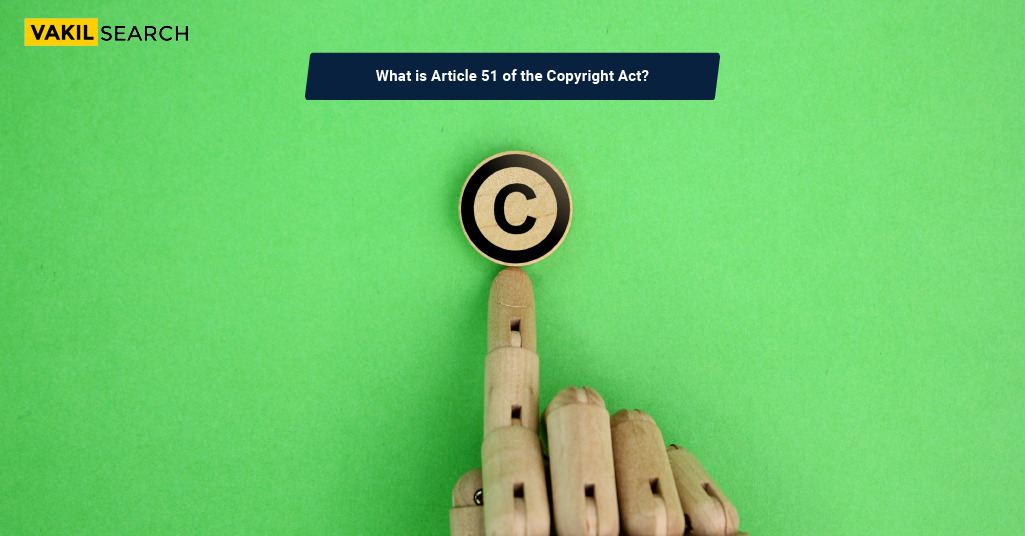Article 51 of the Copyright Act in India grants exclusive rights to broadcasting organisations, safeguarding their content and fostering innovation while balancing the interests of copyright holders.
Introduction
The Copyright Act of India is a critical legal framework that governs the protection of intellectual property rights. Among its many sections and provisions, Article 51 holds a distinctive place. In this article, we delve into the intricate details and significance of Article 51, drawing comparisons with its more commonly known counterpart, Section 51. To enhance understanding, we’ll employ diagrams and flowcharts to elucidate the legal intricacies.
Understanding Article 51
Article 51 of the Copyright Act addresses a crucial aspect of copyright law—rights of broadcasting organisations. Broadcasting organisations play a pivotal role in disseminating copyrighted content to the public, whether it be through television, radio, or other electronic means.
Key Elements of Article 51:
- Exclusive Right: Article 51 grants broadcasting organisations exclusive rights over the content they broadcast, subject to the conditions and restrictions outlined in the Act.
- Reproduction and Communication to the Public: It covers the reproduction of broadcasts and their communication to the public, encompassing both primary and secondary transmissions.
- Term of Protection: Article 51 provides protection for broadcasting organisations for a specified duration.
Comparing Article 51 and Section 51
To gain a comprehensive understanding of Article 51, it’s essential to compare and contrast it with Section 51, which deals with copyright infringement. Here’s a comparative analysis:
Article 51 (Broadcasting Organisations)
- Focuses on protecting the rights of broadcasting organisations.
- Grants exclusive rights over broadcasts, including reproduction and communication to the public.
- Ensures protection for a specified duration.
Section 51 (Copyright Infringement)
- Pertains to copyright infringement and violations.
- Outlines various forms of copyright infringement, such as reproduction, distribution, public performance, etc.
- Imposes penalties and consequences for copyright infringement, including civil and criminal liabilities.
Exploring the Significance of Article 51
Article 51 holds significant importance in the realm of intellectual property and copyright law. Here are some key aspects that highlight its significance:
- Protection of Broadcasting Organisations: Article 51 safeguards the interests of broadcasting organisations, ensuring that they have exclusive rights over their broadcasts. This protection is crucial in an era where broadcasting is a significant medium for disseminating content.
- Promoting Innovation: By granting exclusive rights, Article 51 encourages broadcasting organisations to invest in creating and broadcasting content. This, in turn, fosters innovation and creativity in the industry.
- Balancing Interests: Article 51 strikes a balance between the rights of broadcasting organisations and the interests of copyright holders. It outlines the conditions under which broadcasting organisations can exercise their exclusive rights.
- International Recognition: Article 51 aligns with international copyright treaties and agreements, ensuring that Indian broadcasting organisations receive protection and recognition worldwide.
Practical Application of Article 51
Let’s explore a real-world example to understand how Article 51 can come into play:
Scenario: A television broadcasting organisation, ‘XYZ TV,’ creates an original television series titled ‘InnovateTech.’ XYZ TV invests significant resources in producing and broadcasting the series.
Application of Article 51:
- Exclusive Rights: Article 51 grants XYZ TV exclusive rights over the broadcast of ‘InnovateTech.’ This means that no other organisation can reproduce or communicate ‘InnovateTech’ to the public without XYZ TV’s permission during the protection period.
- Term of Protection: Article 51 specifies a certain duration of protection for broadcasting organisations. During this period, XYZ TV has the exclusive right to broadcast ‘InnovateTech.’
- Protection Against Infringement: If another broadcasting organisation attempts to broadcast ‘InnovateTech’ without XYZ TV’s authorisation, Article 51 enables XYZ TV to take legal action against the infringing party.
Challenges and Controversies Surrounding Article 51
While Article 51 is a crucial provision in the Copyright Act, it is not without its challenges and controversies. Two key aspects to consider are:
- Scope of Protection: One contentious issue is determining the scope of protection granted to broadcasting organisations under Article 51. Questions arise about what constitutes a ‘broadcast’ and how far the exclusive rights of broadcasting organisations extend. As technology evolves, defining the boundaries of protection becomes increasingly complex.
- International Implications: Broadcasting organisations often operate across borders, distributing content globally. This raises questions about the international recognition and enforcement of rights granted by Article 51. Ensuring harmonisation with international copyright treaties is an ongoing challenge.
The Future of Article 51: Evolving in the Digital Age
As technology continues to advance and the broadcasting landscape evolves, the relevance and application of Article 51 may undergo transformations. Two notable trends to watch for are:
- Digital Broadcasting: With the rise of digital platforms and streaming services, Article 51 may need to adapt to encompass new forms of broadcasting. This includes addressing issues related to online streaming, on-demand services, and the protection of digital content.
- Copyright Enforcement: As copyright enforcement becomes more critical in the digital age, Article 51 could play a pivotal role in protecting the rights of broadcasting organisations against online piracy and unauthorised distribution. The Act may need to evolve to address emerging challenges in copyright enforcement.
Conclusion
In the dynamic world of intellectual property rights and copyright law, Vakilsearch plays a significant role in assisting broadcasting organisations, content creators, and copyright holders. We understand the complexities and challenges that can arise in protecting intellectual property, including the rights outlined in Article 51 of the Copyright Act.
Our mission is to empower broadcasting organisations and copyright holders by offering expert guidance and services that facilitate compliance with copyright laws. Vakilsearch provides comprehensive legal resources, consultations, and support to navigate the intricate landscape of intellectual property rights.
By leveraging our expertise and resources, broadcasting organisations and content creators can ensure that their rights are not only protected but also enforced effectively. Vakilsearch stands as a valuable ally in promoting innovation and creativity in the broadcasting industry while respecting the rights of all stakeholders.










